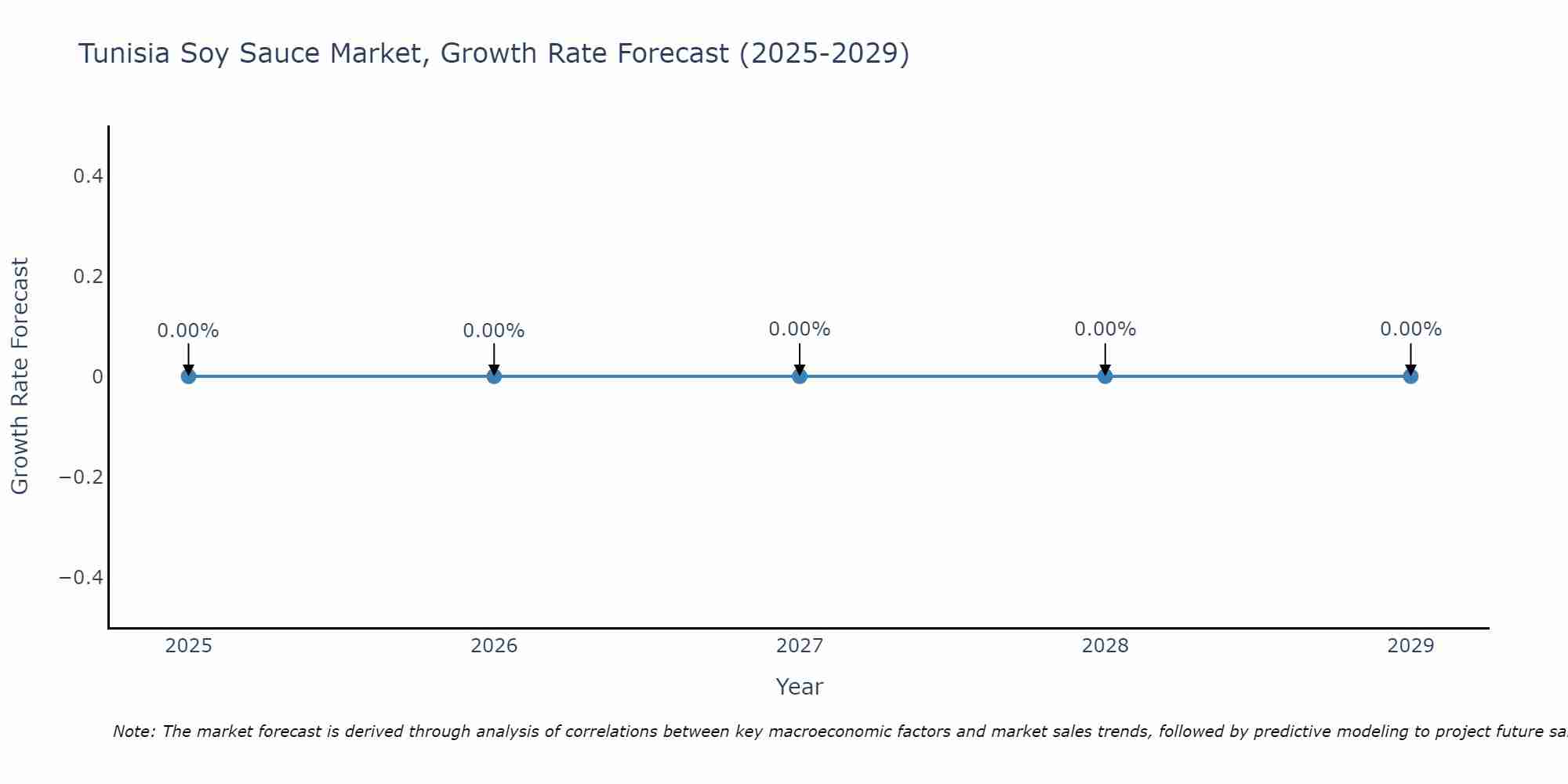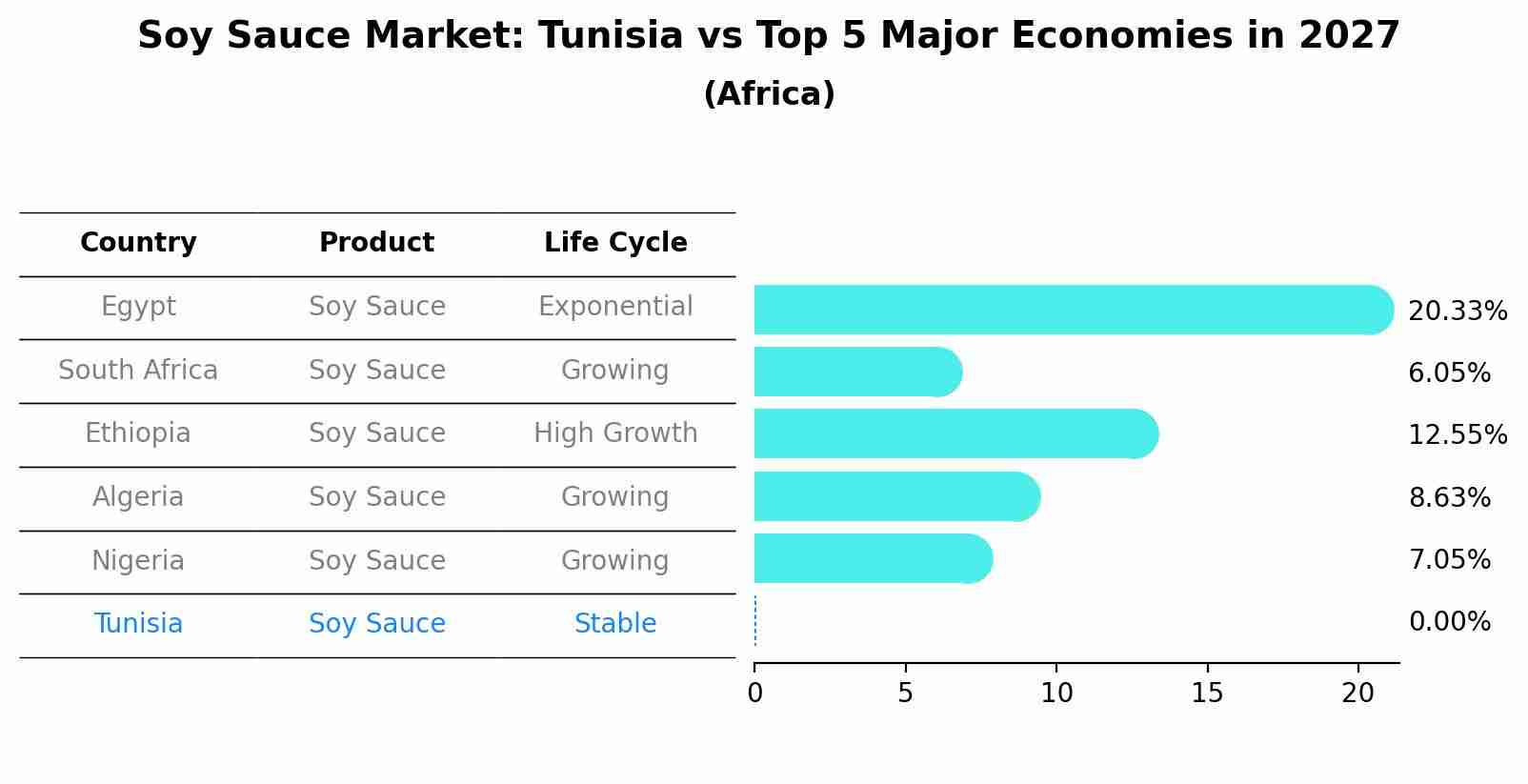Tunisia Soy Sauce Market (2025-2031) Outlook | Growth, Trends, Value, Forecast, Analysis, Revenue, Size, Share, Industry & Companies
| Product Code: ETC073693 | Publication Date: Jun 2021 | Updated Date: Jun 2025 | Product Type: Report | |
| Publisher: 6Wresearch | Author: Ravi Bhandari | No. of Pages: 70 | No. of Figures: 35 | No. of Tables: 5 |
Tunisia Soy Sauce Market Size Growth Rate
The Tunisia Soy Sauce Market is likely to experience consistent growth rate gains over the period 2025 to 2029. The growth rate starts at 0.00% in 2025 and reaches 0.00% by 2029.

Soy Sauce Market: Tunisia vs Top 5 Major Economies in 2027 (Africa)
Tunisia's Soy Sauce market is anticipated to experience a stable growth rate of 0.00% by 2027, reflecting trends observed in the largest economy Egypt, followed by South Africa, Ethiopia, Algeria and Nigeria.

Tunisia Soy Sauce Market Overview
The Tunisia Soy Sauce Market is experiencing steady growth driven by increasing consumer demand for Asian cuisine, growing awareness of health benefits associated with soy products, and the influence of global food trends. Local manufacturers are expanding their product offerings to cater to diverse consumer preferences, with varieties such as light soy sauce, dark soy sauce, and low-sodium options gaining popularity. The market is also witnessing the entry of international brands, introducing competition and driving innovation in product formulations and packaging. Retail channels, including supermarkets, hypermarkets, and online platforms, play a crucial role in the distribution of soy sauce products across Tunisia. As consumer palates continue to evolve and demand for ethnic flavors rises, the Tunisia Soy Sauce Market presents opportunities for both local and international players to capitalize on this growing segment.
Tunisia Soy Sauce Market Trends
Currently, the Tunisia Soy Sauce Market is experiencing a growing demand for healthier, natural, and organic soy sauce options. Consumers are increasingly seeking soy sauce products that are free from artificial additives, preservatives, and genetically modified ingredients. There is also a rising trend towards low-sodium and gluten-free soy sauce varieties to cater to health-conscious and dietary-restricted individuals. Additionally, the market is witnessing a surge in the popularity of premium and gourmet soy sauce products, with unique flavors and high-quality ingredients. Sustainability and ethical sourcing practices are becoming important factors for consumers, driving the demand for soy sauce brands that prioritize transparency and environmental responsibility in their production processes. Overall, the Tunisia Soy Sauce Market is evolving to meet the changing preferences and needs of modern consumers who prioritize health, quality, and sustainability.
Tunisia Soy Sauce Market Challenges
In the Tunisia Soy Sauce Market, some challenges faced include competition from established local condiment brands, limited consumer awareness and acceptance of soy sauce as a staple condiment in Tunisian cuisine, and the relatively higher price point of imported soy sauce compared to traditional condiments. Additionally, logistical challenges in terms of distribution and shelf space in retail outlets can affect the market penetration of soy sauce products. Adapting the flavor profile of soy sauce to suit local tastes and preferences, as well as investing in marketing efforts to educate consumers about the benefits and uses of soy sauce, are key strategies to overcome these challenges and drive growth in the Tunisia Soy Sauce Market.
Tunisia Soy Sauce Market Investment Opportunities
The Tunisia Soy Sauce Market presents promising investment opportunities due to the increasing consumer demand for Asian cuisine and the growing trend of healthy eating. The market is currently underserved, with limited domestic production and a reliance on imports. Investors could consider opportunities in local soy sauce production facilities to meet the rising demand and reduce dependence on imports. Additionally, there is potential for introducing innovative soy sauce products tailored to the Tunisian market preferences, such as low-sodium or organic options. Collaborations with local restaurants and food manufacturers could also be explored to expand distribution channels and increase market penetration. Overall, investing in the Tunisia Soy Sauce Market offers the potential for growth and profitability in a sector poised for development.
Tunisia Soy Sauce Market Government Policy
Government policies in Tunisia related to the Soy Sauce Market primarily focus on food safety regulations and import restrictions. The Tunisian government has established quality standards and regulations for food products, including soy sauce, to ensure consumer safety and protect public health. Import restrictions are in place to promote the domestic production of food products, which may impact the availability and pricing of imported soy sauce in the market. Additionally, the government may offer support or incentives to domestic soy sauce producers to encourage growth and innovation in the industry. Overall, government policies in Tunisia aim to regulate the quality of soy sauce in the market while also supporting domestic producers.
Tunisia Soy Sauce Market Future Outlook
The future outlook for the Tunisia Soy Sauce Market appears optimistic, driven by increasing consumer awareness and adoption of Asian cuisine, health-conscious food trends, and the growing popularity of plant-based diets. The market is expected to witness steady growth as consumers seek out flavorful and versatile condiments like soy sauce. Additionally, the rising demand for international flavors and the influence of global culinary trends are likely to further propel the market`s expansion. With key players focusing on product innovation, including introducing organic and low-sodium options, the Tunisia Soy Sauce Market is poised for continued growth and opportunities for market penetration and diversification in the coming years.
Key Highlights of the Report:
- Tunisia Soy Sauce Market Outlook
- Market Size of Tunisia Soy Sauce Market, 2021
- Forecast of Tunisia Soy Sauce Market, 2031
- Historical Data and Forecast of Tunisia Soy Sauce Revenues & Volume for the Period 2021 - 2031
- Tunisia Soy Sauce Market Trend Evolution
- Tunisia Soy Sauce Market Drivers and Challenges
- Tunisia Soy Sauce Price Trends
- Tunisia Soy Sauce Porter's Five Forces
- Tunisia Soy Sauce Industry Life Cycle
- Historical Data and Forecast of Tunisia Soy Sauce Market Revenues & Volume By Product Type for the Period 2021 - 2031
- Historical Data and Forecast of Tunisia Soy Sauce Market Revenues & Volume By Brewed for the Period 2021 - 2031
- Historical Data and Forecast of Tunisia Soy Sauce Market Revenues & Volume By Blended for the Period 2021 - 2031
- Historical Data and Forecast of Tunisia Soy Sauce Market Revenues & Volume By Application for the Period 2021 - 2031
- Historical Data and Forecast of Tunisia Soy Sauce Market Revenues & Volume By Household for the Period 2021 - 2031
- Historical Data and Forecast of Tunisia Soy Sauce Market Revenues & Volume By Food Industry for the Period 2021 - 2031
- Tunisia Soy Sauce Import Export Trade Statistics
- Market Opportunity Assessment By Product Type
- Market Opportunity Assessment By Application
- Tunisia Soy Sauce Top Companies Market Share
- Tunisia Soy Sauce Competitive Benchmarking By Technical and Operational Parameters
- Tunisia Soy Sauce Company Profiles
- Tunisia Soy Sauce Key Strategic Recommendations
Frequently Asked Questions About the Market Study (FAQs):
1 Executive Summary |
2 Introduction |
2.1 Key Highlights of the Report |
2.2 Report Description |
2.3 Market Scope & Segmentation |
2.4 Research Methodology |
2.5 Assumptions |
3 Tunisia Soy Sauce Market Overview |
3.1 Tunisia Country Macro Economic Indicators |
3.2 Tunisia Soy Sauce Market Revenues & Volume, 2021 & 2031F |
3.3 Tunisia Soy Sauce Market - Industry Life Cycle |
3.4 Tunisia Soy Sauce Market - Porter's Five Forces |
3.5 Tunisia Soy Sauce Market Revenues & Volume Share, By Product Type, 2021 & 2031F |
3.6 Tunisia Soy Sauce Market Revenues & Volume Share, By Form, 2021 & 2031F |
4 Tunisia Soy Sauce Market Dynamics |
4.1 Impact Analysis |
4.2 Market Drivers |
4.3 Market Restraints |
5 Tunisia Soy Sauce Market Trends |
6 Tunisia Soy Sauce Market, By Types |
6.1 Tunisia Soy Sauce Market, By Product Type |
6.1.1 Overview and Analysis |
6.1.2 Tunisia Soy Sauce Market Revenues & Volume, By Product Type, 2018 - 2027F |
6.1.3 Tunisia Soy Sauce Market Revenues & Volume, By Brewed, 2018 - 2027F |
6.1.4 Tunisia Soy Sauce Market Revenues & Volume, By Blended, 2018 - 2027F |
6.2 Tunisia Soy Sauce Market, By Application |
6.2.1 Overview and Analysis |
6.2.2 Tunisia Soy Sauce Market Revenues & Volume, By Household, 2018 - 2027F |
6.2.3 Tunisia Soy Sauce Market Revenues & Volume, By Food Industry, 2018 - 2027F |
7 Tunisia Soy Sauce Market Import-Export Trade Statistics |
7.1 Tunisia Soy Sauce Market Export to Major Countries |
7.2 Tunisia Soy Sauce Market Imports from Major Countries |
8 Tunisia Soy Sauce Market Key Performance Indicators |
9 Tunisia Soy Sauce Market - Opportunity Assessment |
9.1 Tunisia Soy Sauce Market Opportunity Assessment, By Product Type, 2021 & 2031F |
9.2 Tunisia Soy Sauce Market Opportunity Assessment, By Application, 2021 & 2031F |
10 Tunisia Soy Sauce Market - Competitive Landscape |
10.1 Tunisia Soy Sauce Market Revenue Share, By Companies, 2021 |
10.2 Tunisia Soy Sauce Market Competitive Benchmarking, By Operating and Technical Parameters |
11 Company Profiles |
12 Recommendations |
13 Disclaimer |
- Single User License$ 1,995
- Department License$ 2,400
- Site License$ 3,120
- Global License$ 3,795
Search
Thought Leadership and Analyst Meet
Our Clients
Related Reports
- Canada Oil and Gas Market (2026-2032) | Share, Segmentation, Value, Industry, Trends, Forecast, Analysis, Size & Revenue, Growth, Competitive Landscape, Outlook, Companies
- Germany Breakfast Food Market (2026-2032) | Industry, Share, Growth, Size, Companies, Value, Analysis, Revenue, Trends, Forecast & Outlook
- Australia Briquette Market (2025-2031) | Growth, Size, Revenue, Forecast, Analysis, Trends, Value, Share, Industry & Companies
- Vietnam System Integrator Market (2025-2031) | Size, Companies, Analysis, Industry, Value, Forecast, Growth, Trends, Revenue & Share
- ASEAN and Thailand Brain Health Supplements Market (2025-2031) | Strategy, Consumer Insights, Analysis, Investment Trends, Opportunities, Growth, Size, Share, Industry, Revenue, Segments, Value, Segmentation, Supply, Forecast, Restraints, Outlook, Competition, Drivers, Trends, Demand, Pricing Analysis, Competitive, Strategic Insights, Companies, Challenges
- ASEAN Bearings Market (2025-2031) | Strategy, Consumer Insights, Analysis, Investment Trends, Opportunities, Growth, Size, Share, Industry, Revenue, Segments, Value, Segmentation, Supply, Forecast, Restraints, Outlook, Competition, Drivers, Trends, Demand, Pricing Analysis, Competitive, Strategic Insights, Companies, Challenges
- Europe Flooring Market (2025-2031) | Outlook, Share, Industry, Trends, Forecast, Companies, Revenue, Size, Analysis, Growth & Value
- Saudi Arabia Manlift Market (2025-2031) | Outlook, Size, Growth, Trends, Companies, Industry, Revenue, Value, Share, Forecast & Analysis
- Uganda Excavator, Crane, and Wheel Loaders Market (2025-2031) | Strategy, Consumer Insights, Analysis, Investment Trends, Opportunities, Growth, Size, Share, Industry, Revenue, Segments, Value, Segmentation, Supply, Forecast, Restraints, Outlook, Competition, Drivers, Trends, Demand, Pricing Analysis, Competitive, Strategic Insights, Companies, Challenges
- Rwanda Excavator, Crane, and Wheel Loaders Market (2025-2031) | Strategy, Consumer Insights, Analysis, Investment Trends, Opportunities, Growth, Size, Share, Industry, Revenue, Segments, Value, Segmentation, Supply, Forecast, Restraints, Outlook, Competition, Drivers, Trends, Demand, Pricing Analysis, Competitive, Strategic Insights, Companies, Challenges
Industry Events and Analyst Meet
Whitepaper
- Middle East & Africa Commercial Security Market Click here to view more.
- Middle East & Africa Fire Safety Systems & Equipment Market Click here to view more.
- GCC Drone Market Click here to view more.
- Middle East Lighting Fixture Market Click here to view more.
- GCC Physical & Perimeter Security Market Click here to view more.
6WResearch In News
- Doha a strategic location for EV manufacturing hub: IPA Qatar
- Demand for luxury TVs surging in the GCC, says Samsung
- Empowering Growth: The Thriving Journey of Bangladesh’s Cable Industry
- Demand for luxury TVs surging in the GCC, says Samsung
- Video call with a traditional healer? Once unthinkable, it’s now common in South Africa
- Intelligent Buildings To Smooth GCC’s Path To Net Zero


















